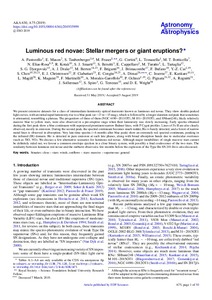Luminous red novae: Stellar mergers or giant eruptions?
A. Pastorello; E. Mason; S. Taubenberger; M. Fraser; G. Cortini; L. Tomasella; M. T. Botticella; N. Elias-Rosa; R. Kotak; S. J. Smartt; S. Benetti; E. Cappellaro; M. Turatto; L. Tartaglia; S. G. Djorgovski; A. J. Drake; M. Berton; F. Briganti; J. Brimacombe; F. Bufano; Y.-Z. Cai; S. Chen; E. J. Christensen; F. Ciabattari; E. Congiu; A. Dimai; C. Inserra; E. Kankare; L. Magill; K. Maguire; F. Martinelli; A. Morales-Garoffolo; P. Ochner; G. Pignata; A. Reguitti; J. Sollerman; S. Spiro; G. Terreran; D. E. Wright
Luminous red novae: Stellar mergers or giant eruptions?
A. Pastorello
E. Mason
S. Taubenberger
M. Fraser
G. Cortini
L. Tomasella
M. T. Botticella
N. Elias-Rosa
R. Kotak
S. J. Smartt
S. Benetti
E. Cappellaro
M. Turatto
L. Tartaglia
S. G. Djorgovski
A. J. Drake
M. Berton
F. Briganti
J. Brimacombe
F. Bufano
Y.-Z. Cai
S. Chen
E. J. Christensen
F. Ciabattari
E. Congiu
A. Dimai
C. Inserra
E. Kankare
L. Magill
K. Maguire
F. Martinelli
A. Morales-Garoffolo
P. Ochner
G. Pignata
A. Reguitti
J. Sollerman
S. Spiro
G. Terreran
D. E. Wright
EDP SCIENCES S A
Julkaisun pysyvä osoite on:
https://urn.fi/URN:NBN:fi-fe2021042826272
https://urn.fi/URN:NBN:fi-fe2021042826272
Tiivistelmä
We present extensive datasets for a class of intermediate-luminosity optical transients known as luminous red novae. They show double-peaked light curves, with an initial rapid luminosity rise to a blue peak (at -13 to -15 mag), which is followed by a longer-duration red peak that sometimes is attenuated, resembling a plateau. The progenitors of three of them (NGC 4490-2011OT1, M 101-2015OT1, and SNhunt248), likely relatively massive blue to yellow stars, were also observed in a pre-eruptive stage when their luminosity was slowly increasing. Early spectra obtained during the first peak show a blue continuum with superposed prominent narrow Balmer lines, with P Cygni profiles. Lines of Fe II are also clearly observed, mostly in emission. During the second peak, the spectral continuum becomes much redder, H alpha is barely detected, and a forest of narrow metal lines is observed in absorption. Very late-time spectra (similar to 6 months after blue peak) show an extremely red spectral continuum, peaking in the infrared (IR) domain. H alpha is detected in pure emission at such late phases, along with broad absorption bands due to molecular overtones (such as TiO, VO). We discuss a few alternative scenarios for luminous red novae. Although major instabilities of single massive stars cannot be definitely ruled out, we favour a common envelope ejection in a close binary system, with possibly a final coalescence of the two stars. The similarity between luminous red novae and the outburst observed a few months before the explosion of the Type IIn SN 2011ht is also discussed.
Kokoelmat
- Rinnakkaistallenteet [27094]
